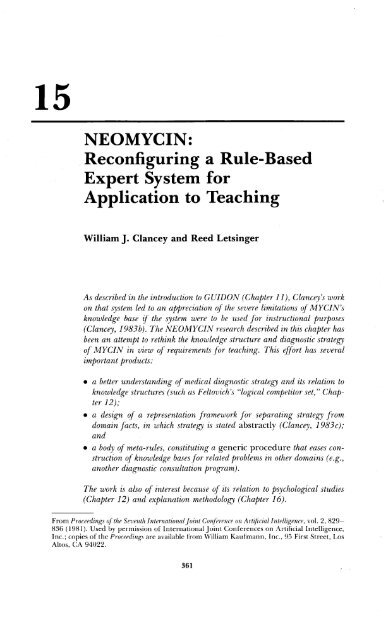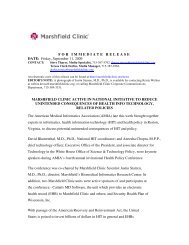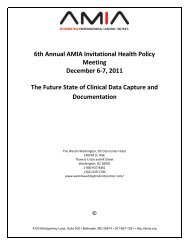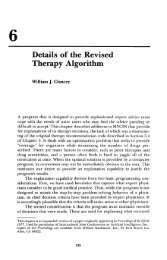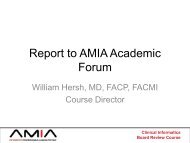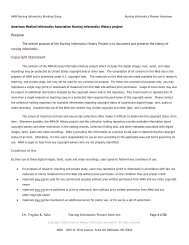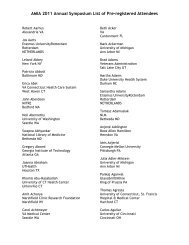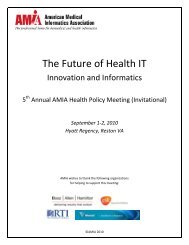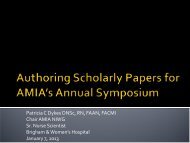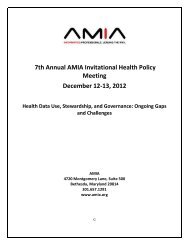Chapter 15 - People
Chapter 15 - People
Chapter 15 - People
You also want an ePaper? Increase the reach of your titles
YUMPU automatically turns print PDFs into web optimized ePapers that Google loves.
<strong>15</strong>NEOMYCIN:. Reconfiguring a Rule-BasedExpert System forApplication to TeachingWilliam J. Clancey and Reed LetsingerAs described 'in the introduction to GUIDON (<strong>Chapter</strong> 11), Clancey's workon that system led to an appreciation of the severe limitations of MYCIN'sknowledge base if the system were to be used for instructional purposes(Clancey, 1983b). The NEOMYCIN research described in this chapter hasbeen an attempt to rethink the knowledge structure and diagnostic strategyof MYCIN in view of requirements for teaching. This ~ffort has severalimportant products,'• a better understanding of medical diagnostic strategy and its relation toknowledge structures (such as F eltovich 's "logical competitor set," <strong>Chapter</strong>12);• a design of a representation framework for separating strategy fromdomain facts, in which strategy is stated abstractly (Clancey, 1983c);and• a body of meta-rules, constituting a generic procedure that eases constructionof knowledge bases for related problems in other domains (e.g.,another diagnostic consultation program).The work is also of interest because of its relation to psychological studies(<strong>Chapter</strong> 12) and explanation methodology (<strong>Chapter</strong> 16).From Proceedings of the Seventh International joint Conjprence on Artificial Intelligence, vol. 2,829-836 (1981). Used by permission of International Joint Conferences on Artificial Intelligence,Inc.; copies of the Proceedings are available from William Kaufmann, Inc., 95 First Street, LosAltos, CA 94022.361
362 NEOMYCIN: Reconfiguring an Expert System for Application to TeachingNEOMYCIN is amedical consultation system in which MYCIN's knowledgebase is reorganized and extended for use in the next version of GUIDON. The new system attempts to capture psychological characteristics ofdiagnostic reasoning, designed to provide a basis for interpreting studentbehavior and teaching diagnostic strategy. This psychological orientationprovides a constraint for making choices about representation and the reasoningprocess. In particular, NEOMYCIN captures the forward-directed,"compiled association" mode of reasoning that characterizes expert behavior.Collection and interpretation of data are focused by the "differential"or "working" memory of hypotheses~ Moreover, the knowledge base is broadenedso that GUIDON can teach a student when to consider a specificinfectious disease and what competing hypotheses to consider, essentially theknowledge a human would need in order to use the MYCIN consultationsystem properly.In order to articulate this knowledge to a student, it was necessary togreatly revise MYCIN's representation. Kinds of knowledge that were procedurallyembedded in MYCIN's rules are stated separately, to make themaccessible to the teaching program. The key idea is to represent explicitlyand separately a domain-independent diagnostic strategy in the form ofmeta-rules, knowledge about a disease taxonomy, causal and datalhypothesisrules, and world facts. In essence, the new representation explicitly structuresand controls the use of the diagnostic rules, simplifying them by isolatingthe basic datal hypothesis relations from their application criteria.A more detailed .discussion of methodological issues in the developmentof NEOMYCIN can be found in Clancey (1984). More recent research,exploiting the features of NEOMYCIN, includes modeling student strategies(London and Clancey, 1982) and stating strategies in explanations(Has ling et al., 1984). With the combination of empirical and knowledgeengineeringinterests, this research also has implications for incorporatingcognitive modeling in new tools for building knowledge bases.<strong>15</strong> 1 Introduction•A knowledge base used in a teaching program must explicitly representwhat a student might need to be told. Development of intelligent tutoringsystems such as SOPHIE (Brown et al., 1975), WHY (Stevens and Collins,1978), 'WUMPUS (Goldstein, 1978), and GUIDON (Clancey, 1979a;1979b) can be viewed, in part, as a problem of knowledge representation.This research has shown the advantages of:• multiple representations of knowledge (e.g., the simulation model andsemantic network in SOPHIE),;
Introduction 363• representations that can be both interpreted and used to generate teachingtext [e.g., Brown's meteorological automata (Brown et aI., 1973) andproduction rules used in WUMPUS and GUIDON];• network representations of knowledge that capture "importance"[SCHOLAR (Carbonell, 1970)], "complexity" or "prerequisite" associations[WUMPUS, BIP (Barr et aI., 1976)], "analogy" and "generalization"relations (WUMPUS); and• representations that allow for variants on expert performance (for modelingthe student) [WEST (Burton, 1979), BUGGY (Brown and. Burton,1978)].In the GUIDON program we have been exploring the problem ofusing MYCIN's rule set as teaching material. MYCIN (Shortliffe, 1976) isa rule-based expert system that provides therapy advice for certain kindsof infectious diseases. It has spawned a class of systems, called EMYCINsystems, that all use the same production rule language and interpreter(van Melle, 1980). GUIDON can operate using the rule set of any EMYCINsystem as subject material.MYCIN's rules were thought to be potentially useful for teaching becauseformal evaluations indicate that MYCIN captures a high level ofexpertise (Yu et aI., 1979b), and modular design and representationalmeta-knowledge enable the program to explain its reasoning (Davis, 1976).Ironically, we have found that it is in precisely these two areas-expertiseand explanatory capability-so important for a successful teaching program,that MYCIN falls short. To solve these problems, we have implementeda new system we call NEOMYCIN.<strong>15</strong>.1.1 The Limitations of MYCIN for Application toTeachingMYCIN is designed to be used as a consultant; consequently, we encounterdifficulties when using it for teaching a student how to be a primary diagnostician.MYCIN's knowledge base is designed to interpret culture resultsfrom the blood and the cerebral-spinal fluid (CSF). But the expertise thatsuggests that such a culture should be taken is not part of the system. Itis the user of MYCIN, the person seeking advice, who will think aboutmeningitis in the first place and order the CSF culture and who will considercompeting hypotheses (and medical tests) that need to be consideredbefore MYCIN is even brought into the case as a consultant. This knowledgeis certainly a critical part of teaching infectious disease diagnosis, butit lies completely outside the scope of the MYCIN knowledge base.Moreover, protocols of experts who solve the same cases as are presentedto MYCIN indicate that the program does not organize or use itsknowledge in the same way a human expert does. This result is not sur-
364 NEOMYCIN: Reconfiguring an Expert System for Application to Teachingprising, for MYCIN was not designed to simulate the process of humanreasoning. The rules make use of the same data a physician uses and someof the same intermediate concepts of disease, but MYCIN's weakly focused,exhaustive search is quite dissimilar from how people reason. For GUIDON, our tutorial program, to articulate and recognize the hierarchicalorganizations of knowledge and search strategies that humans find useful,we need to reorganize MYCIN's rule set and incorporate an explicit modelof human diagnostic reasoning, the kind indicated by psychologicalresearch in medical problem solving (Miller, 1975; Rubin, 1975; Paukerand Szolovits, 1977; Swanson et al., 1977; Elstein et al., 1978; Kassirer andGorry, 1978) (see also <strong>Chapter</strong> 6). In particular, the model must exhibit:• focused, forward-directed use of data (including trigger associations thatsuggest diagnoses);• follow-up questions that establish the disease process (part of what aphysician calls "forming a picture of the patient"); and• management of a changing "working" memory of hypotheses under consideration.In this sense, the development of NEOMYCIN is an attempt to synthesizeprevious medical psychological research and to analyze its application tothe infectious disease problem domain.<strong>15</strong>.1.2 Developing a Psychological Model byModifying EMYCINA psychological model of diagnostic reasoning cannot be represented usingthe EMYCIN representation alone, that is, by simply rewriting MYCIN'srules. For example, the idea of asking a follow-up question is not allowedby MYCIN's rule interpreter. Also, we need to apply rules selectively andnonexhaustively. In general, the rule representation and interpreter mustbe modified; rules need to be organized so they can be selectively appliedin different ways.Many of the changes to EMYCIN are straightforward. They illustratehow local changes to the "inference engine" of a program can dramaticallychange how the knowledge base is used in problem solving. For example,a simple change is to provide for data-directed reasoning so new data cancause new subgoals to be set up and pursued. In MYCIN, an antecedentrule is tried whenever some piece of information required by the rule'spremise becomes known. A NEOMYCIN trigger rule is similar, but it allowsfor new data to be requested in order to apply the rule. For example, onetrigger rule is "if the patient has a stiff neck and a headache, then considermeningitis."1 When a physician hears that the patient has a stiff neck, theIThe medical examples in this paper are simplified; we make no claims about completenessor accuracy. They are for purposes of illustration only.
Introduction 365IF: 1) The infection is meningitis,2) The subtype of meningitis is bacterial,3) Only circumstantial evidence is available,4) The patient is at least 17 years old, and5) The patient is an alcoholicTHEN: There is suggestive evidence that diplococcus-pneumoniae is an organism causing themeningitisFIGURE <strong>15</strong>-1Typical MYCIN rule.association to meningitis might come to mind, prompting him or her todetermin"e whether the patient has a headache as well. This behavior isbrought about in NEOMYCIN by simply marking trigger rules to distinguishthem from ordinary antecedent rules and "throwing a switch" in therule interpreter so that pursuing new subgoals is enabled for trigger rules.Besides interpreter changes, different kinds of knowledge had to beseparated out of the rules and represented explicitly. Figure <strong>15</strong>-1 shows atypical (paraphrased) MYCIN rule, an example of "compiled expertise."We can list some of the individual steps of reasoning and knowledgesources out of which it is composed, unknown to MYCIN, but explicitlyrepresented in NEOMYCIN:• Analysis of other rules shows that this rule (to determine the organism)is only invoked after it has been established that the patient has aninfection. Thus four major subgoals are established in this order: Is therean infection? Is it meningitis? Is it bacterial? Is it Diplococcus pneumoniae?Each of these subgoals hypothesizes a more specific cause of disease.Thus, the ordering of clauses constitutes a top-down refinement strategy. However,MYCIN does not know about this specialization hierarchy. It doesnot even know that Diplococcus pneumoniae is a bacterium. Perhaps mostserious of all for meeting our teaching goals, MYCIN omits intermediatecategories such as acute/chronic meningitis and gram-negative meningitisthat physicians find helpful. In NEOMYCIN these categories arerepresented explicitly in an etiological taxonomy by allowing parameters tobe specializations of one another.• The clause about the patient's age prevents MYCIN from asking if achild is an alcoholic. MYCIN does not know that the ordering of theseclauses is important, or what the relationship is. In NEOMYCIN theseworld relations are captured by separate screening rules.• When there is laboratory evidence (a culture with visible organisms), thisrule does not apply (clause 3). However, a companion rule still allowsthe circumstantial evidence of alcoholism to be considered, but gives itless weight. This principle of considering circumstantial evidence evenwhen there are hard, physical observations of the cause is not explicitlyknown to MYCIN. The principle is compiled identically into 40 pairs ofrules, rather than being stated as a reasoning rule for combining hard
366 NEOMYCIN: Reconfiguring an Expert System for Application to Teachingand soft evidence. NEOMYCIN has rules for reasoning about the evidenceit has collected, so connections between data and hypotheses areseparate from the mntexts in which they will be used.These forms of knowledge-a (top-down) strategy, an etiological taxonomy,world facts, evidence-weighing rules-form a basis for a psychologicalmodel about knowledge organization and access, but they are notsufficient. Consider the above rule again. How does a physician rememberto ask about alcoholism? How does he or she remember the connectionwith Diplococcus? Experts use a rich set of organizational aids and mnemonicsfor accessing their knowledge.For example, one can think of taking the patient's history as a processof determining the differential of possible causes. Under this strategy, theexpert follows the principle (rule model) that "compromised host conditionsbroaden the differential by suggesting special causes." Alcoholism isone of these conditions. So the low-level behavior of asking "Is the patientan alcoholic?" occurs in the context of the general process of diagnosis. Inexplaining the question to a student, it is important to be able to step backfrom the immediate concern for supporting a particular disorder and toarticulate the general goals and methods of diagnosis itself. At the lowestlevel, the association to Diplococcus might be remembered as a simple causalstory: alcoholics breathe in their own secretions, so organisms found in themouth find their way to the lungs, causing pneumonia.In summary, NEOMYCIN incorporates these psychological aids forteaching diagnosis:1. a representation of diagnostic strategy that provides a meaningful, usefulorientation for collecting data ("attempt to broaden the differential");2. structural associations for indexing evidence to consider (abstractions suchas "compromised host conditions" and rule models that use them); and3. rule justifications that relate data/hypothesis associations to underlyingcausal processes.<strong>15</strong>.1.3 The Need for Focusing StrategiesAs we mentioned above, we cannot use MYCIN for teaching about meningitisdiagnosis because it does not know how patients with meningitistypically appear when the physician first sees them and what competingdisorders need to be considered. But if we simply added knowledge aboutmore diseases and when to order laboratory tests we would be in trouble:a top-down diagnostic strategy is inadequate for a broader range of problems.The combinatorics of the search problem for medical diagnosis makeit impossible for an expert to consider every infection, to work top-down.Initial information most commonly brings the physician into the middle ofhis or her taxonomic hierarchy (via the "compiled associations" such as the
An Overview of NEOMYCIN 367trigger rule given above). Working from the middle, the physician mustfirst look upward to focus the possibilities ("Is it a traumatic process? cancer?")and then refine downward. The approach used by MYCIN's rulesonly works because the user of the program is the one who focuses onmeningitis. MYCIN can verify that the historical and laboratory evidenceis consistent with meningitis, but it does not have the knowledge for consideringmeningitis in the first place. The program has only two infectionsto consider and does not know about other causes of the findings reportedby the user.For the program itself to shoulder this focusing burden (so that GUIDON can teach it to a student), we should more properly think of its areaof expertise as being related to the observations a user will bring to it ratherthan the problems it knows how to confirm and refine. Thus MYCIN's areaof expertise is "meningitis~'; in contrast, NEOMYCIN deals with "abnormalneurological signs" or "headache and fever." In order to give NEOMYCINthe capability to deal with a broader range of problems, to actually have itthink of other causes of headache and fever, we did the following:1. expanded the etiological knowledge to include broad categories of other,noninfectious problems, such as "toxic problem," and "neoplastic problem";2. incorporated the focusing strategy of "group and d~fferentiate" so the programcould manage this broader range of possibilities; and3. added knowledge about disease processes, knowledge that cuts orthogonallyacross the etiological taxonomy, so diseases can be compared accordingto location, extent of the disorder, duration, severity, etc., in order toenhance the program's ability to apply the focusing strategy.<strong>15</strong> • 2An Overview of NEOMYCINA few words about the character of MYCIN's problem domain are in order.We assume that a diagnosis or problem solution consists of an ordered listof problem causes that have been selected from a fixed, hierarchical spaceof hypotheses (e.g., "cancer process," "chronic meningitis") or categories ofdisease and pathophysiological states (e.g., "mass lesion in the brain"). Weassume that an informant presents a problem to the program, which acts asa consultant, the role played by a student using GUIDON. There are twotypes of data: soft data (circumstantial or historical) and hard data (laboratoryor direct measurements). Some of the evidence may be missing,and conclusions will usually be uncertain.A schematic of the NEOMYCIN system (Figure <strong>15</strong>-2) illustrates thevarious knowledge sources and their relation to the strategic knowledgeand differential (the set of diagnoses under consideration). These com-
368 NEOMYCIN: Reconfiguring an Expert System for Application to TeachingCausal rulestrigger rulessuggestdiagnostichypotheses[Data] >antecedentrulesconcludecauses(diseasestates andcategories)8causal rulesultimately concludeetiologiesmeta-rule actionsrequest newdata directlyor by applyingselecteddomain rulesEtiologicaltaxonomyDiagnosticmeta-strategymeta-rule premisesreference domainrules, taxonomy,and diseaseprocess knowledge[Differential]meta-rule premisesreference currenthypothesesFIGURE <strong>15</strong>-2 Components of the NEOMYCIN system.ponents are shown as icons expanded III subsequent figures. The interpretationof Figure <strong>15</strong>-2 follows.• There are four kinds of domain rules:o Causal rules form a network of pathophysiological states and diseasecategories, ultimately linking raw observations (incoming data) to theetiological taxonomy.o Trigger rules associate data with etiologies, which are placed as hypothesesin the differential (maintained so that general causes arereplaced by their more specific descendents).
A Sample Case 369METARULE397 (for the task group-and-differentiate)IF: There are two items on the differential that differ in some disease process featureTHEN: Ask a question that differentiates between these two kinds of processesFIGURE <strong>15</strong>-3A typical strategy rule.o Data/hypothesis rules associate circumstantial and laboratory data withdiseases, as do trigger rules, but only those rules focused by the differentialare tried when the data are circumstantial (i.e., the associationsthat "come to mind" are those hypotheses already in the differential,as well as the nodes of the etiological taxonomy that hang belowthe hypotheses of the differential).o Screening rules (not shown) form a hierarchy of abstractions and restrictionson data (e.g., "if the patient is not immunosuppressed, thenhe is not an alcoholic"); they are applied by backward chaining, in anattempt to determine a datum without asking the user .• Other domain knowledge (not shown), orthogonal to the hierarchies ofcause, considers diseases as processes having a location, extent, progressionof symptoms, etc.o One form of disease process knowledge is represented as a framelikedescription associated with diseases in the etiological- taxonomy and isused to differentiate among them.o A second form consists of a list of process-oriented, follow-up questionsthat should be immediately asked when some disease categoryor pathophysiological state is implicated (e.g., to establish when symptomsoccurred and their ordering and change in severity) .• The meta-strategy for doing diagnosis consists of a hierarchy of domainindependentmeta-rules. In general, these meta-rules examine the differentialand make use of the etiological taxonomy, causal associations,and disease process knowledge to decide what datum to request next. Atypical strategy rule is shown in Figure <strong>15</strong>-3.The annotated typescript in the next section shows how these formsof knowledge interact in practice. Subsequent sections provide a few moredetails about the representation.<strong>15</strong>.3 A Sample CaseTo illustrate the ideas presented above, a simple case was presented to asimple version of NEOMYCIN (there are generally only one or two rulesto establish each hypothesis). Only the collection of circumstantial evidence
370 NEOMYCIN: Reconfiguring an Expert System for Application to Teachingis shown in Figure <strong>15</strong>-4. Although this trace of reasoning is very detailed,it is included here because it is precisely the process by which data, hypotheses,and rules interact that is at issue.Observe the many different reasons why a question is asked; this is areflection of the complexity of the diagnostic strategy. NEOMYCIN is hypothesis-and data-directed. In contrast, MYCIN only asks a question toevaluate a clause of a rule for the goal it is pursuing. Its rules are notsorted by conclusion, so its questions appear to skip back and forth randomlyamong hypotheses. It is not backward chaining per se that distinguishesthe two systems, for NEOMYCIN essentially backward chainsthrough its strategic rules. It is NEOMYCIN's forward, nonexhaustive reasoningand management of a space of hypotheses that make it reason morelike a human does.7-Dec-80 16:18:25--------PAT I ENT -1--------task MAKE-DIAGNOSIS METARULE384 succeeded.task IDENTIFY-PROBLEM METARULE385 succeeded.Initial tasks are unconditional. The first step is to collect identifying data, followed by the reasons for seekingadvice.Please enter information about the patient.1)2)NameAge~ MIKE 4Please describe the chief complaint:(Enter keyword or phrase.)** DIPLOPIASexMALERaceCAUCASIANDiplopia is recognized to be a neurological sign which triggers meningitis, and leads to a follow-up question(associated with NEUROSIGN) ....antecedent RULE376 succeeded.Conclude: NEUROSIGN is YES (1.0)antecedent RULE426 succeeded.Conclude: INFECTIOUS-PROCESS is MENINGITIS (.7)Differential: Adding MENINGITIS3) How many days has Mike had abnormal neurologic signs?** 13Trying evidence rules: LENSIGN --> CHRONIC-MENINGITISTrying RULE524; succeeded.Conclude: MENINGITIS is ACUTE-MENINGITIS (-.3)Conclude: MENINGITIS is CHRONIC-MENINGITIS (.3)FIGURE <strong>15</strong>-4 Trace of NEOMYCIN's reasoning for a samplecase. [For brevity, the trace of rule conclusions is of the form"Conclude: PARAMETER is VALUE (CF)." Parameters are alwaysassociated with the context, here PATIENT-I. Strategictasks are sometimes abbreviated. Figure <strong>15</strong>-5 relates meta-rulesto tasks.]
A Sample Case 371Differential:replace MENINGITIS with CHRONIC-MENINGITISAnother antecedent rule is associated with diplopia . ...antecedent RULE373 succeeded.Conclude: BRAIN-PRESSURE is YES (.8)Brain pressure suggests a mass lesion-these antecedent rules al/ model immediate, forward inferences thatwe observed in experts . ...antecedent RULE375 succeeded.Conclude: MASS-LESION is YES (.72)Differential: Adding MASS-LESIONAny other information?** HEADACHEHere a trigger antecedent rule requires more information before it can be applied ....4) Does Mike have a stiff neck?** YESantecedent RULE424 succeeded.Conclude: INFECTIOUS-PROCESS is MENINGITIS (.91)Any other information?** NOThe program now takes initiative, starting its main history-taking task of "establish the hypothesis space"(hereafter. EHS). The differential has new, unexamined elements, so the "group and differentiate" (G&O)task is invoked first. METARULE400 recognizes that the etiological ancestors of chronic meningitis have notbeen explored, so an attempt is made to confirm (task PURSUE-HYPOTHESIS = PH) that an infectiousprocess is causing the problem.Enter EHS loop: focus = NILtask METARULE427 succeeded.Review differential: MASS-LESION CHRONIC-MENINGITISEnter G&D loop: focus = NILtask METARULE400 succeeded.Enter PH loop: focus = INFECTIOUS-PROCESStask METARULE410 succeeded.5) Is Mike febrile?** Yantecedent RULE423 succeeded.Conclude:DISORDER-ETIOLOGY is INFECTIOUS-PROCESS (.7)There are no further questions to ask; an interrupt returns control to the G&O task. No rules succeed, socontrol returns to the EHS task. The "explore and refine" (E&R) task Silently refines mass lesion, expandingthe differential by different etiological categories, and so triggering return to the EHS task.observed STOP-PURSUING METARULE408Repeating G&D loop: focus =INFECTIOUS-PROCESSRepeating EHS loop: focus = INFECTIOUS-PROCESStask METARULE428 succeeded.Enter E&R loop: focus = INFECTIOUS-PROCESStask METARULE429 succeeded.FIGURE <strong>15</strong>-4 continued
372 NEOMYCIN: Reconfiguring an Expert System for Application to Teachingobserved STOP-EXPLORING METARULE407Repeating EHS loop: focus = INFECTIOUS-PROCESStask METARULE427 succeeded.The first step is again to review the differential, a process observed in experts. Process features of brainabscess and chronic meningitis are compared: they both occur in the central nervous system, are chronicproblems, and are infectious, but brain abscess is a localized problem. NEOMYCIN asks a question todiscriminate on this basis . ...Review differential: BRAIN-ABSCESS HEMATOMAPUS-IN-BRAIN CHRONIC-MENINGITISEnter G&D loop: focus = INFECTIOUS-PROCESStask METARULE397 succeeded.6) Does Mike have focal neurological signs?•• NOTrying evidence rules: FOCALSIGNS ---+ BRAIN-ABSCESSRULE179 failed due to clause 1The program has not been supplied with knowledge for confirming other causes of mass lesion (e.g.,traumatic hemorrhage, tumor), so it is unable to continue its grouping operation and begins an explorationcycle ....Repeating G&D loop: focus = INFECTIOUS-PROCESSRepeating EHS loop: focus = INFECTIOUS-PROCESStask METARULE428 succeeded.Enter E&R loop: focus = INFECTIOUS-PROCESStask METARULE402 succeeded.Enter PH loop: focus = BRAIN-ABSCESStask METARULE409 succeeded.Now directly focusing on brain abscess, the program "realizes" that data supplied earlier are relevant(RULE433). Chronic meningitis is then considered by refining it and pursuing specific causes. Pursuing TB,NEOMYCIN follows the strategy of confirming the first ("enabling") step in the disease process: contCict withthe organism ....Trying evidence rules: MASS-LESION ---+ BRAIN-ABSCESSTrying RULE433; succeeded.Conclude: INFECTIOUS-PROCESS is BRAIN-ABSCESS (.216)Observed STOP-PURSUING METARULE408Repeating E&R loop: focus = BRAIN-ABSCESStask METARULE429 succeeded.Enter PH loop: focus = TB-MENINGITIStask METARULE411 succeeded.7) Does Mike have a TB risk factor?•• YESTrying evidence rules: TBRISK ---+ TB-MENINGITISTrying RULE525; succeeded.observed STOP-PURSUING METARULE408Focusing strategies dictate that a sibling be considered next. Fungal meningitis is refined, and a child,cryptococcus, pursued . ...Repeating E&R loop: focus = TB-MENINGITIStask METARULE401 succeeded.Enter PH loop: focus = FUNGAL-MENINGITISFIGURE <strong>15</strong>-4 continued
A Sample Case 373Repeating E&R loop: focus = FUNGAL-MENINGITIStask METARULE399 succeeded.Enter PH loop: focus = CRYPTOCOCCUSA cancer patient is at some risk of getting cryptococcal meningitis. Rather than asking directly if the patienthas cancer, the program models an expert's efficient casting of a wider net by asking a more generalquestion. Specifically, there are "screening rules," that lead it to determine first if the patient isimmunosuppressed (RULE39S) and then compromised (RULE343). This is the only form of backwardchaining that occurs in NEOMYCIN. 2task METARULE431 succeeded.--[0] Findout: LEUKEMIA--[1] Findout: IMMUNOSUPPRESSEDTrying RULE343;8) Is Mike a compromised host (e.g. alcoholic, sickle-cell-disease,immunosuppressed)?** YESRULE343 failed due to clause 1If the patient were not compromised, the program could have concluded that he is not immunosuppressed(RULE343). Now it is unsure and must ask direct/yo If the patient is not immunosuppressed, the program willknow that he does not have leukemia (RULE39S). The answer of LEUKEMIA below impliesimmunosuppressed, so RULE39S fails, and the original goal is determined.--[1] Finished: IMMUNOSUPPRESSED9) Is Mike immunosuppressed (e.g. corticosteroid therapy, cytotoxic drugtherapy, radiation therapy, leukemia)?** LEUKEMIAI will assume that leukemia is one of the diagnoses of MikeRULE395 failed due to clause 1--[0] Finished: LEUKEMIATrying evidence rules: LEUKEMIA -+ CRYPTOCOCCUSTrying RULE056; succeeded.Conclude: FUNGAL-MENINGITIS is CRYPTOCOCCUS (.3)Repeating E&R loop: focus = CRYPTOCOCCUStask METARULE401 succeeded.Attention turns to a sibling. Again, the "enabling step" is asked about first . ...Enter PH loop: focus = COCCIDIOIDEStask METARULE411 succeeded.10) Has the patient ever been to a cocci-endemic area?** NOTrying evidence rules: COCCI-ENDEMIC -+ COCCIDIOIDESRULE570 failed due to clause 1RULE287 failed due to clause 1observed STOP-PURSUING METARULE408Repeating E&R loop: focus = COCCIDIOIDESRepeating EHS loop: focus = COCCIDIOIDEStask METARULE430 succeeded.2Ed. notf: A later version of NEOMYCIN accomplishes this form of inference by meta-rules.
374 NEOMYCIN: Reconfiguring an Expert System for Application to TeachingHaving exhausted its limited knowledge, the program finds no other relevant, hypothesis-oriented questionsto ask. Several general questions are asked ....11) Is Mike receiving any medications?•• NORepeating EHS loop: focus = COCCIDIOIDEStask RULE430 succeeded.12) Has Mike been recently hospitalized?•• NORepeating EHS loop: focus = COCCIDIOIDESIf additional data had been supplied, new hypotheses might have been placed on the differential andstrategies for grouping or refining might have been called into play once again. This ends the history-takingprocess. Next the program would order laboratory tests, process them, and perhaps return to gatheringcircumstantial evidence.FIGURE <strong>15</strong>-4 continued<strong>15</strong>.4 The Diagnostic Meta-StrategyFormalizing the diagnostic strategy from protocol analysis was the mostdifficult part of designing NEOMYCIN. Figure <strong>15</strong>-5 shows the generaloutline of the meta-strategy. Each nonterminal node in the tree stands fora task that is achieved by a set of rules. An important aspect of our modelof diagnosis is that the process can be taught as a task-posing activity: theproblem solver thinks in terms of what he or she is trying to do (e.g., toconsider unusual causes and so broaden the differential) in order to bringknowledge sources to mind. Thus the meta-strategy is structured so thetasks make sense as things that experts try to do.Figure <strong>15</strong>-5 shows that the main object of the meta-strategy is to decidewhat data to collect next (invoke MYCIN's FINDOUT routine), generallyby focusing on some hypothesis in the differential. Aside from collectinginitial information, the basic idea is that collecting circumstantial evidenceis a process of establishing the hypothesis space. This process takes the formof considering what could cause the reported data, grouping and refiningthe differential, and asking general questions. 3 A great deal of what wemight call heuristic confidence is placed in the general questions, which constitutethe outline of the "history-taking process" as it is generally taughtto medical students. However, strategies for using causal and disease processknowledge enable the expert to be an efficient problem solver in acombinatorially large space, and these strategies are generally not taught.3Group and differentiate is used here in the loose sense of establishing general focus on a processthat is consistent with hypotheses suggested independently by the data. Clustering (in multipleways) and discriminating, the usual meaning of the term, is one operation for achieving thisfocus.
The Diagnostic Meta-Strategy 375Make-diagnosis [384]Establish-hypothesis-spaceProcess-hard-data[rules]initialinfochiefcomplaint~&drre~not compact[393]process split[397]top unexplored[400]'--------- ~Pu rsue-hypothesis~\~skipped-evidence[409]trigger\. [410]enabling[411]~Findout[5 rules]Jother[431].1FIGURE <strong>15</strong>-5 NEOMYCIN's diagnostic meta-strategy. (Rulenumbers in brackets appear in the sample trace.)The implementation is in terms of hierarchical meta-rules,4 which asa whole constitute the meta-strategy_ Figure <strong>15</strong>-6 illustrates how the rulesfor a given task are treated as a pure production system-they are repeat-4S0 called because they indirectly control the invocation of the domain-dependent objectrules. Davis's conception of meta-rules was that they would directly order object-level rules.However, in our theory of diagnostic strategy, meta-rules reason about the state of the differentialand knowledge sources (kinds of evidence) that could change it in desirable ways.Thus, our meta-rules choose kinds of object rules (hypothesis-confirming, process-oriented,ca~sal).
376 NEOMYCIN: Reconfiguring an Expert System for Application to TeachingTASK--- ............- "( RULE-1 RULE-2 • • • RULE-N )"-END CONDITION TEST"' \,SUBTASK-1SUBTASI
Etiological Taxonomy, Causal and Disease Process Knowledge 377DISORDER-ETIOLOGYMENINGITIS CYSTITIS BRAIN-ABSCESS-- ---- --/'-- --/'ACLJTF.-MENI~IGITISCHHmllCMENINGITiSBACTERIAL VIRAL PARTIAL-RXGRAM-NEG SKIN-GRGS (OTHER ORGS)TEl FUNGAL/\CRY rTOCOCCUSCOCCIFIGURE <strong>15</strong>-7 Portion of etiological taxonomy. (Links representspecialization of cause.)Causal knowledge (Figure <strong>15</strong>-8) is represented as rules modified by acertainty factor, as are all MYCIN rules. A causal rule of the form "if Athen B" implies that A is caused by B, the direction of the association thatis most generally useful for interpreting data and refining hypotheses.These rules mention data parameters, taxonomic parameters, or state-categoryparameters. State-category parameters stand for pathophysiological states orcategories of disease (e.g., a mass lesion in the brain). In linking theseconcepts together, it is important to properly distinguish between causaland subtype links. (While we might say that an unknown mass lesion, a
378 NEOMYCIN: Reconfiguring an Expert System for Application to TeachingtMASS-LESIONJ/ \\~INCR BRAIN PRESSURETUMOR HEMATOMA PUS-IN-BRAIN\ ANEURYSMI ---/ ~IMYCOTIC ANEURYSMI //---SUBDURALEMPYEMA\--- ------\}//-FIGURE <strong>15</strong>-8 Portion of causal rule network, showingconnection to etiological taxonomy.--BRAINABSCESS\I//space-occupying substance, is caused by a tumor, it is more proper to representa tumor as a kind of mass lesion_) Causal rules are used by the"explore and refine" task to work backward from state-category hypothesesin the differential to prior causes, and ultimately to diagnostic hypothesesin the etiological taxonomy (as shown in Figure <strong>15</strong>-8).Disease process knowledge is represented as a frame associated withtaxonomic parameters_ Slots are process descriptors such as EXTENT, LOCATION, and COURSE associated with a literal value and a pointer tothe parameter to establish it. For example, associated with BRAIN -ABSCESS is the triple (EXTENT FOCAL FOCALSIGNS), meaning that theextent of the disease is focal and this can be determined by asking aboutfocal signs. Disease process knowledge is orthogonal to the etiological taxonomy,making it useful for grouping and discriminating hypotheses (seesample trace, before question 6)_
Some Limitations 379<strong>15</strong> • 6Related ResearchBesides the intelligent computer-assisted instruction (ICAI) projects citedin the introduction, our work has been motivated by previous research inteaching problem-solving strategies [e.g., Papert (1970); Brown et al.(1977); vVescourt and Hemphill (1978)]. We believe NEOMYCIN is thefirst attempt to formalize a runnable psychological model of diagnosticstrategy that can be presented to a student. As should be obvious from ouranalysis, a considerable debt is owed to the medical problem-solving literature,cited above.Both Reggia (1978) and Aikins (1980) modified the MYCIN system tomake it more acceptable to physicians, particularly to improve knowledgeacquisition. Aikins's use of an etiological taxonomy and trigger rules, derivedfrom Rubin's work, is particularly close to our approach. However,we go a step further by representing strategic knowledge separately indomain-independent form. Our teaching application has also made clearthe importance of disease process knowledge for broadening the diagnosticrange of a consultation program.Research in cognitive psychology has been helpful to us, particularlystudies at the Learning Research Development Center (Anderson et al.,1981; Chi et al., 1981) (see also <strong>Chapter</strong> 12) in modeling the differencesbetween experts and novices in geometry and physics problem solving. Tosome extent, our attempt to "decompile" MYCIN's knowledge is the inverseof Anderson's task of modeling how a novice composes and generalizesknowledge from experience.<strong>15</strong> • 7Some LimitationsPople's experience has been useful to point out limitations in our design.He shows that a simplistic causal network is not adequate when an attemptis made to represent all of general internal medicine (Pople, 1982). Forexample, when the causal connections between data and the taxonomy arelong and complex, it may not be feasible to follow each path (possiblecause). His "bridge concepts" [similar to Feltovich's "logical competitor sets"(see <strong>Chapter</strong> 12)] are attempts to model how an expert jumps over to distal,tentative hypotheses. They essentially provide a quick way to find the intersectionof causes for a set of disease symptoms.Similarly, Rubin's thesis illustrates a number of strategies for combininghypotheses (for example, relating complications and causes) that wehave not yet found to be important in MYCIN's domain. To this extent,
380 NEOMYCIN: Reconfiguring an Expert System for Application to Teachingour model is not the complete story of human diagnostic reasoning, but itcan be built on as we expand our experience into other domains. We donot yet understand how an expert organizes his or her differential; howcontext is saved and restored from interrupts; how urgency, cost, and humanvalues factor into the diagnostic process; and so on.<strong>15</strong>.8 Summary of What We LearnedTo teach diagnosis, it is useful to have a psychological model of problemsolving. In particular, we need to incorporate into our model the medicalknowledge and strategies an expert uses for initial problem formulation.An expert thinks in terms of a hierarchy of causes and the process characteristicsof a disease so that he or she can order the data and the search.Moreover, an expert has learned "compiled associations" that allow him orher to efficiently associate hypotheses with data (e.g., trigger rules, Pople's"bridge concepts"), and cast a wide net of questions (e.g., general, screening,and follow-up questions).Also, we need to represent the various kinds of knowledge explicitlyso that they can be accessible for teaching. Our method is to representstrategic knowledge in domain-independent form, wholly separate fromthe medical knowledge described above. This requires that the medicalknowledge be organized so that it can be indexed by the strategies (e.g.,as the disease-process frame links abstract features of any disease, such asprogression over time, to means for establishing this information in a particularcase).In a sense, we join cognitive psychologists [e.g., Anderson et al. (1981)and Rumelhart and Norman (1980)] in rediscovering the procedural!declarative problem in the context of how knowledge becomes transformedthrough experience. We recognize that the expert has composed associations,so he or she makes wide, tentative jumps between data and hypotheses.However, we represent these compiled associations declarativelyfor use in instruction (spelling out the diagnostic procedure in detail), andwe record justifications of data-interpretation rules to allow for explanationof reasoning.<strong>15</strong> • 9Future ResearchDevelopment of NEOMYCIN and GUIDON version 2 will proceed in parallel.Comparisons of NEOMYCIN's performance to MYCIN's will indicateif our more principled representation has changed the performance of the
Future Research 381system. This is a possibility because we have simplified some rules so theyrepresent more closely the associations a human expert normally remembers.Preliminary runs give comparable results, though NEOMYCIN asksfewer questions because of its focused approach. We might also use NEOMYCIN's representation and meta-rules for diagnosis in a nonmedical domain,to test the domain-independence of the model.GUIDON version 2 will use the NEOMYCIN representation, makingit possible to articulate diagnostic strategy. A new phase of developmentwill begin as we try to use the diagnostic strategies (and variants of them)for interpreting student behavior, leading to capabilities to evaluate partialsolutions and provide assistance. The first version of GUIDON attemptedthese things, but was not able to recognize or suggest psychologically validapproaches. .ACKNOWLEDGMENTSWe are especially grateful to Timothy Beckett, M.D., for his patient explanationsand willingness to be directed in our discussions. Bruce Buchananand Bob London have also contributed to the GUIDON project. This researchhas been supported in part by an ARPA and ONR contract(NOOO 14-79C-0302). Computational resources were provided by theSUMEX-AIM facility (NIH grant RR00785).


